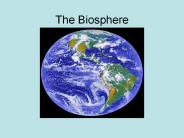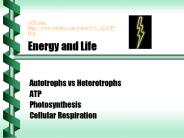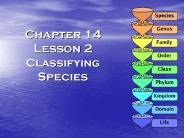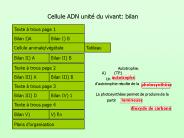Autotroph PowerPoint PPT Presentations
All Time
Recommended
Warm up: What is an autotroph? How do autotrophs obtain food? Autotrophs: An organism that produces its own food. Uses chloroplast. Convert light energy to ...
| PowerPoint PPT presentation | free to download
Title: PowerPoint Presentation Author: Jason E. Meade Last modified by: Martinez, Maria O Created Date: 4/12/2002 12:43:12 AM Document presentation format
| PowerPoint PPT presentation | free to download
photosynthesis or autotrophic nutrition aerobic respiration cellular respiration lactic acid cellular respiration & photosynthesis cellular respiration ...
| PowerPoint PPT presentation | free to download
Energy Flow: Autotrophs Sunlight is the main source of energy for life on Earth. Autotrophs (also known as producers) have chlorophyll that captures the energy that ...
| PowerPoint PPT presentation | free to download
Energy Flow: Autotrophs Sunlight is the main source of energy for life on Earth. Autotrophs (also known as producers) have chlorophyll that captures the energy that ...
| PowerPoint PPT presentation | free to download
Mangroves can tolerate really tough conditions, including salt water, but they ... The multicellular algae (aka seaweeds) are divided into 3 ... Sea lettuce ...
| PowerPoint PPT presentation | free to view
Autotrophs Sunlight is the main source of energy for life on Earth. ... Food Chains are a series of steps in which organisms transfer energy by eating or being eaten.
| PowerPoint PPT presentation | free to download
Title: WAS Orlando 1-24-01 AES Presentation Subject: Biofilter Kinetics Author: James M. Ebeling Keywords: Biofilter, Beadfilters, Kinetics Description
| PowerPoint PPT presentation | free to download
Chemosynthesis: chemical energy sources (ex. H2S) Ex., producers in deep-sea vent communities are chemosynthetic bacteria (animals still dependent on oxygen from ...
| PowerPoint PPT presentation | free to view
Title: Which of the following organisms are autotrophs? algae some bacteria plants some protozoans all of the above Author: SDHS Last modified by
| PowerPoint PPT presentation | free to download
Autotrophic plants can convert CO2 into organic compounds (triose sugar phosphates) Biosynthesis occurs in chloroplasts (double-membrane; outer membrane permeable, ...
| PowerPoint PPT presentation | free to view
Organism that has the ability to produce it's own energy/food. Photosynthesis (light) ... Organisms that feed on meat: Meat-eater. Bear, anteater. Omnivore ...
| PowerPoint PPT presentation | free to view
CO2 is released and a 6-carbon molecule called citric acid is produced. As the cycle continues, citric acid is broken down into a 4-carbon molecule, ...
| PowerPoint PPT presentation | free to view
Organisms able to synthesize nutritive substances required for growth (auto=self, troph=feed/grow) ... take up from external, troph=feed/grow) Today. Plant ...
| PowerPoint PPT presentation | free to download
UMass Environmental Engineering Research Project Perchlorate Remediation Using a Novel Autotrophic Perchlorate Reducing Microbial Community Principal Investigators:
| PowerPoint PPT presentation | free to download
Carbon Cycles through Organisms in Respiration autotrophes heterotrophes
| PowerPoint PPT presentation | free to download
Chapter 11 Protists Protist Charateristics Protists unicellular or multicellular eukaryotes that may be autotrophic or heterotrophic Autotrophs are organism ...
| PowerPoint PPT presentation | free to view
Energy and Life Autotrophs vs Heterotrophs ATP Photosynthesis Cellular Respiration Autotrophic Organisms Use light energy to make their own food Provide ULTIMATE ...
| PowerPoint PPT presentation | free to download
Photosynthesis The Flow of Energy Autotrophs vs. Heterotrophs Autotrophs self-feeders , an organism that makes all its own organic matter from inorganic ...
| PowerPoint PPT presentation | free to view
... mitochondries Pr sence possible de chlorophylle h t rotrophe autotrophe si chloroplastes autotrophe si chlorophylle Pas de chloroplastes Pas de vacuole ...
| PowerPoint PPT presentation | free to view
THE BASICS OF PHOTOSYNTHESIS Almost all plants are photosynthetic autotrophs, as are some bacteria and protists Autotrophs generate their own organic matter through ...
| PowerPoint PPT presentation | free to download
Photosynthesis Chapter 8 Autotrophs vs. Heterotrophs Autotrophs: Plants and some other types of organisms that use light energy from SUNLIGHT to make their own food.
| PowerPoint PPT presentation | free to view
The Biosphere Vocabulary Ecology Biosphere Species Population Community Ecosystem Biome Producer Consumer Autotroph Heterotroph Decomposer Habitat Learning Target I ...
| PowerPoint PPT presentation | free to download
The Biosphere Vocabulary Ecology Biosphere Species Population Community Ecosystem Biome Producer Consumer Autotroph Heterotroph Decomposer Learning Target I can ...
| PowerPoint PPT presentation | free to download
KINGDOM ARCHEABACTERIA Unicellular Prokaryotes Extremophiles (heat, salinity, acid, etc) Autotrophic/chemosynthetic and heterotrophic DNA structure similar to ...
| PowerPoint PPT presentation | free to view
BOTANY The Study of the plant kingdom Examples Characteristics of Plant Kingdom Are multicellular eukaryotes that are photosynthetic autotrophs Contain chloroplasts ...
| PowerPoint PPT presentation | free to download
Photosynthesis Photosynthesis in nature Autotrophs: biotic producers; make their own food photoautotrophs; chemoautotrophs Heterotrophs: biotic consumers; obtain ...
| PowerPoint PPT presentation | free to download
Plants are autotrophic and can produce their food by photosynthesis. What is Photosynthesis, to know it, please study the s carefully.
| PowerPoint PPT presentation | free to download
Ecosystem Components BIOTIC Components of an Ecosystem PRODUCERS CONSUMERS DECOMPOSERS (type of Consumer) PRODUCERS (autotrophs) Terrestrial: Green plants Aquatic ...
| PowerPoint PPT presentation | free to view
The Six Kingdoms What kingdom do these organisms belong to? Plant multicellular eukaryotes autotrophs What kingdom do these organisms belong to?
| PowerPoint PPT presentation | free to view
Kingdoms protista, fungi, plantae, animalia Protista Unicellular Some autotrophic-algae Some heterotrophic Mostly found in aquatic habitats Endosymbionts live ...
| PowerPoint PPT presentation | free to view
Bioenergetics The Big Picture - energy flows through - matter recycles Producers = Autotrophs - organisms which can make their food - plants, algae, some bacteria ...
| PowerPoint PPT presentation | free to download
Classification Go to Section: Kingdom Eubacteria Go to Section: E. coli Streptococcus Cell Type Prokaryote Number of Cells Unicellular Nutrition Autotroph or ...
| PowerPoint PPT presentation | free to view
Classification of Kingdom Monera Based on Mode of Nutrition 1) ... Commensalism Autotrophic bacteria: ...
| PowerPoint PPT presentation | free to download
Bacteria: The Monera Kingdom Bacteria are classified into two groups: Eubacteria (true bacteria) and Archaebacteria (Ancient Bacteria). They are autotrophic or ...
| PowerPoint PPT presentation | free to view
3-2 Energy Flow Two energy sources: Sunlight (Photosynthesis) Inorganic chemicals (Chemosynthesis) Autotrophs (Producers)- capture energy & make food Heterotrophs ...
| PowerPoint PPT presentation | free to download
KINGDOM PLANTAE CHAPTERS 27-31 CHARACTERISTICS Autotrophic, eukaryotic, multicellular, primarily diploid but some triploid (corn) Plant-like protists (algae) is the ...
| PowerPoint PPT presentation | free to view
Kingdom Plantae All plants are eukaryotic autotrophs making food from sunlight through photosynthesis. Plants have cell walls made of cellulose.
| PowerPoint PPT presentation | free to view
ATP song https://www.youtube.com/watch?v=V_xZuCPIHvk Energy and Life Autotrophs vs Heterotrophs ATP Photosynthesis Cellular Respiration
| PowerPoint PPT presentation | free to download
Archaea Resemble bacteria superficially but may be more closely related to eukaryotes than bacteria May be heterotrophs or autotrophs Methanogens
| PowerPoint PPT presentation | free to download
Photosynthesis SPI.3.3 Compare and contrast photosynthesis and cellular respiration in terms of energy transformation. Energy Ability to do work Autotroph Heterotroph ...
| PowerPoint PPT presentation | free to view
Taxonomy and Classification The Six Kingdoms Archaebacteria Prokaryotic Unicellular Reproduces asexually Heterotrophic, but sometimes autotrophic Heterotrophic ...
| PowerPoint PPT presentation | free to download
PHOTOSYNTHESIS AUTOTROPHS Auto = self Troph = eating Organisms that can produce their own food (energy) from inorganic materials (sunlight) HETEROTROPH Hetero = other ...
| PowerPoint PPT presentation | free to download
A: Discovery Channel LIFE Scientific name = Dionaea muscipula Kingdoms! Biology 11 Eubacteria Prokaryotic Autotrophs and Heterotrophs Unicellular Some capable of ...
| PowerPoint PPT presentation | free to view
Kingdom largest taxa, includes many types of organism with some similarities 2 ... Plantea: (Plants) a. Eukaryotic b. Multicellular c. Autotrophic ...
| PowerPoint PPT presentation | free to download
... ER, lysosomes Heterotrophs, autotrophs Domain Eukarya Examples: Animals, plants, ... Biodiversity Author: Windows User Last modified by: Windows User Created Date:
| PowerPoint PPT presentation | free to download
... Autotrophs that perform photosynthesis contain chemicals called pigments. A pigment is a molecule that absorbs ... and important pigment for ...
| PowerPoint PPT presentation | free to download
Cellule ADN unit du vivant: bilan Texte trous page 1 Autotrophie. A) (TP1 Bilan I)A Bilan I) B autotrophe Un d autotrophie r sulte de la photosynth se
| PowerPoint PPT presentation | free to download
... Global warming Autotrophs vs ... only eat meat Omnivores Eat plants and meat Detritivores and Decomposers Feeds on plant and animal remains Energy ...
| PowerPoint PPT presentation | free to view
Food Webs and Pyramids Feeding Interactions Terms Autotroph(Producers) - Plants, produce energy from the sun. How? Heterotroph(Consumers) - obtain energy from ...
| PowerPoint PPT presentation | free to download
... is the branch of biology concerned with the grouping and naming of ... make their own food (autotroph) using energy derived from minerals coming ...
| PowerPoint PPT presentation | free to view
LAND PLANTS AND THEIR EVOLUTION Chapter 19 Characteristics of Plants Multicellular autotrophs Cell wall of cellulose Food stored as starch Evolved from green algae
| PowerPoint PPT presentation | free to view
Plants and Inorganic Nutrients Animals Heterotrophic Plants - Autotrophic What is plant nutrition? Organic nutrition photosynthesis Inorganic nutrition ...
| PowerPoint PPT presentation | free to download
Protists Protist Characteristics Live in water Eukaryotic Most are unicellular, some are multicellular (algae) Protist Characteristics Some are autotrophic (can make ...
| PowerPoint PPT presentation | free to download
ECOLOGY Nutrition & Energy Flow How do organisms obtain energy? Autotrophs & Producers: - Organisms that use energy from the sun or energy stored in chemical ...
| PowerPoint PPT presentation | free to view
























































